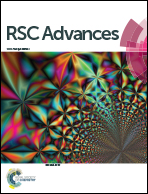Synthesis of sodium polyacrylate–bentonite using in situ polymerization for Pb2+ removal from aqueous solutions
Abstract
Polymer/clay composites have attracted a great deal of interest because of their wide applications in environmental protection. In this study, a sodium polyacrylate–bentonite material (PAANa–Bent), as an adsorbent for heavy metal ions, is synthesized for the first time using in situ polymerization. A series of analytical methods including FTIR, zeta potential measurements, SEM, TG/DTA, DSC, a N2 adsorption–desorption isotherm study and XRD were used to characterize PAANa–Bent. Furthermore, to evaluate the heavy metal ion adsorption capability of PAANa–Bent, batch experiments were conducted using Pb2+ as an adsorbate. The results demonstrate that PAANa–Bent was prepared successfully and the layered structure of bentonite was protected during polymerization. PAANa–Bent has more negative surface charges and a better dispersity than the original bentonite (O-Bent). The maximum adsorption capacity of PAANa–Bent is 70.41 mg g−1 at pH = 6, t = 300 min and T = 25 °C, an increase of 113% compared with O-Bent. A kinetic study shows that the adsorption process of PAANa–Bent obeys a pseudo-second-order model and the best-fit adsorption isotherm is a Freundlich isotherm, indicating the heterogeneous nature of PAANa–Bent. Besides, desorption experiments suggest that the PAANa–Bent can be regenerated easily with 0.1 M HCl as a stripping agent and the desorption ratio was still more than 91% after four cycles. Overall, the results indicate the potential of PAANa–Bent as a low-cost and highly efficient adsorbent for Pb2+ removal from aqueous solutions.


 Please wait while we load your content...
Please wait while we load your content...